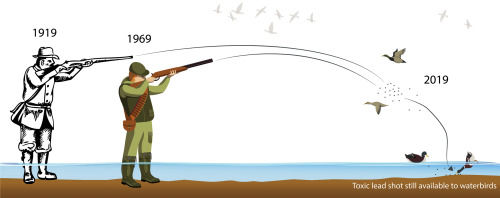当前位置:
X-MOL 学术
›
Sci. Total Environ.
›
论文详情
Our official English website, www.x-mol.net, welcomes your feedback! (Note: you will need to create a separate account there.)
Toxic lead gunshot persists accessible to waterbirds after a 33-year ban on their use.
Science of the Total Environment ( IF 9.8 ) Pub Date : 2020-01-22 , DOI: 10.1016/j.scitotenv.2020.136876 Niels Kanstrup 1 , Anthony D Fox 1 , Thorsten Johannes Skovbjerg Balsby 1
Science of the Total Environment ( IF 9.8 ) Pub Date : 2020-01-22 , DOI: 10.1016/j.scitotenv.2020.136876 Niels Kanstrup 1 , Anthony D Fox 1 , Thorsten Johannes Skovbjerg Balsby 1
Affiliation

|
Use of lead shot for hunting was banned under legislation on 26 Ramsar sites in Denmark from 1986, based on evidence of poisoning in waterbirds ingesting lead shot and high lead shot pellet densities in Danish wetland sediments caused by intensive hunting. To assess the fate of lead shot from hunting prior to 1986 and the degree to which such shot remains available to waterbirds, this study replicated the survey of shot pellet densities in substrates in Ringkøbing Fjord undertaken in the late 1970s. 287 shotgun pellets (282 lead, five steel) were recovered from 123 sediment samples at four locations, equivalent to a mean of 127 pellets m-2 in the top 20 cm of the sediment at the four locations, in certain hot spots equating to >250 kg lead ha-1, broadly similar to densities found in the 1970s. Possible explanations were given for the persistence of such high lead shot densities despite >30 years of regulation, during which time steel shot has been widely used as the alternative to lead. Field experiments showed that steel shot corroded in the marine environment, which likely contributes to lower steel shot densities found in this study. It is concluded that lead gunshot pellet dispersal and accumulation in natural ecosystems remains as a persistent and irreversible hazard to wildlife and ecosystems. Based on these Danish experiences, it is urgently recommended that international and national bodies in countries where hunting with lead shot continues recognise these results and act to prevent the accumulation of this toxic metal.
中文翻译:

在禁水33年后,水鸟仍然可以使用有毒的铅射击。
1986年以来,根据立法,丹麦禁止在拉姆萨尔26个地点使用铅铅打猎,这是根据证据表明,水鸟在密集的狩猎过程中会吸收丹麦铅湿地沉积物中铅铅和高铅粒沉淀物的密度而导致中毒。为了评估1986年之前狩猎导致的铅丸的命运以及水鸟可利用的铅丸的程度,这项研究重复了1970年代后期在Ringkøbing峡湾进行的底物中铅丸密度的调查。从四个位置的123个沉积物样本中回收了287粒gun弹丸(282铅,五种钢),相当于在四个热点的四个热点中,沉积物顶部20 cm处平均有127个m-2颗粒。 250 kg ha-1铅,大致类似于1970年代的密度。尽管有超过30年的法规规定,但仍对如此高的铅丸密度的持久性给出了可能的解释,在此期间,钢丸被广泛用作铅的替代物。现场实验表明,钢丸在海洋环境中受到腐蚀,这可能有助于降低本研究中发现的钢丸密度。结论是,铅弹丸的散布和在自然生态系统中的积累仍然是对野生动植物和生态系统的持续和不可逆转的危害。根据丹麦的这些经验,迫切建议在使用铅丸打猎的国家中的国际和国家机构继续认识到这些结果,并采取行动防止这种有毒金属的积累。在此期间,钢丸被广泛用作铅的替代品。现场实验表明,钢丸在海洋环境中受到腐蚀,这可能有助于降低本研究中发现的钢丸密度。结论是,铅弹丸的散布和在自然生态系统中的积累仍然是对野生动植物和生态系统的持续和不可逆转的危害。根据丹麦的这些经验,迫切建议在使用铅丸打猎的国家中的国际和国家机构继续认识到这些结果,并采取行动防止这种有毒金属的积累。在此期间,钢丸被广泛用作铅的替代品。现场实验表明,钢丸在海洋环境中受到腐蚀,这可能有助于降低这项研究中发现的钢丸密度。结论是,铅弹丸的散布和在自然生态系统中的积累仍然是对野生动植物和生态系统的持续和不可逆转的危害。根据丹麦的这些经验,迫切建议在使用铅丸打猎的国家中的国际和国家机构继续认识到这些结果,并采取行动防止这种有毒金属的积累。结论是,铅弹丸的散布和在自然生态系统中的积累仍然是对野生动植物和生态系统的持续和不可逆转的危害。根据丹麦的这些经验,迫切建议在使用铅丸打猎的国家中的国际和国家机构继续认识到这些结果,并采取行动防止这种有毒金属的积累。结论是,铅弹丸的散布和在自然生态系统中的积累仍然是对野生动植物和生态系统的持续和不可逆转的危害。根据丹麦的这些经验,迫切建议在使用铅丸打猎的国家中的国际和国家机构继续认识到这些结果,并采取行动防止这种有毒金属的积累。
更新日期:2020-01-22
中文翻译:

在禁水33年后,水鸟仍然可以使用有毒的铅射击。
1986年以来,根据立法,丹麦禁止在拉姆萨尔26个地点使用铅铅打猎,这是根据证据表明,水鸟在密集的狩猎过程中会吸收丹麦铅湿地沉积物中铅铅和高铅粒沉淀物的密度而导致中毒。为了评估1986年之前狩猎导致的铅丸的命运以及水鸟可利用的铅丸的程度,这项研究重复了1970年代后期在Ringkøbing峡湾进行的底物中铅丸密度的调查。从四个位置的123个沉积物样本中回收了287粒gun弹丸(282铅,五种钢),相当于在四个热点的四个热点中,沉积物顶部20 cm处平均有127个m-2颗粒。 250 kg ha-1铅,大致类似于1970年代的密度。尽管有超过30年的法规规定,但仍对如此高的铅丸密度的持久性给出了可能的解释,在此期间,钢丸被广泛用作铅的替代物。现场实验表明,钢丸在海洋环境中受到腐蚀,这可能有助于降低本研究中发现的钢丸密度。结论是,铅弹丸的散布和在自然生态系统中的积累仍然是对野生动植物和生态系统的持续和不可逆转的危害。根据丹麦的这些经验,迫切建议在使用铅丸打猎的国家中的国际和国家机构继续认识到这些结果,并采取行动防止这种有毒金属的积累。在此期间,钢丸被广泛用作铅的替代品。现场实验表明,钢丸在海洋环境中受到腐蚀,这可能有助于降低本研究中发现的钢丸密度。结论是,铅弹丸的散布和在自然生态系统中的积累仍然是对野生动植物和生态系统的持续和不可逆转的危害。根据丹麦的这些经验,迫切建议在使用铅丸打猎的国家中的国际和国家机构继续认识到这些结果,并采取行动防止这种有毒金属的积累。在此期间,钢丸被广泛用作铅的替代品。现场实验表明,钢丸在海洋环境中受到腐蚀,这可能有助于降低这项研究中发现的钢丸密度。结论是,铅弹丸的散布和在自然生态系统中的积累仍然是对野生动植物和生态系统的持续和不可逆转的危害。根据丹麦的这些经验,迫切建议在使用铅丸打猎的国家中的国际和国家机构继续认识到这些结果,并采取行动防止这种有毒金属的积累。结论是,铅弹丸的散布和在自然生态系统中的积累仍然是对野生动植物和生态系统的持续和不可逆转的危害。根据丹麦的这些经验,迫切建议在使用铅丸打猎的国家中的国际和国家机构继续认识到这些结果,并采取行动防止这种有毒金属的积累。结论是,铅弹丸的散布和在自然生态系统中的积累仍然是对野生动植物和生态系统的持续和不可逆转的危害。根据丹麦的这些经验,迫切建议在使用铅丸打猎的国家中的国际和国家机构继续认识到这些结果,并采取行动防止这种有毒金属的积累。



























 京公网安备 11010802027423号
京公网安备 11010802027423号